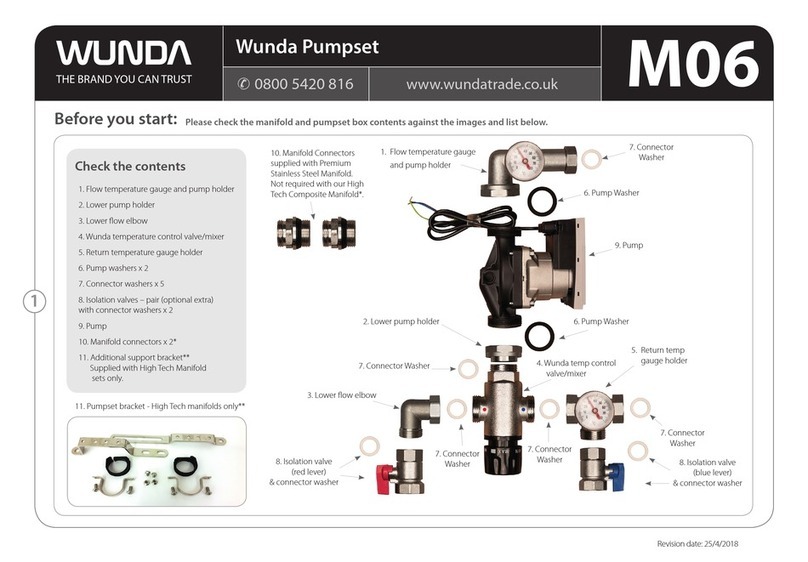
5
Temperature control supplementary information.
Floor surface temperatures
Before introducing heat into the floor heating system check with the
final floor finish supplier about maximum floor surface temperatures.
Generally a maximum floor surface temperature of 29ºC should not
be exceeded however many wooden floor finishes have a maximum
floor surface temperature of 27 ºC and must be layed in conjunction
with relevant underlay and moisture barriers.
We advise the use of floor probes in conjunction with room
thermostats be used in order to limit floor surface temperatures and
avoid damage to chosen floor finish.
In particularly large areas several probes and thermostats may be
required.
Wooden oor coverings
When installing wooden floor coverings over floor heating the floor
surface temperature must not exceed 27 ºC. Floor probes in
conjunction with room thermostats must be used in order to limit
floor surface temperatures and avoid damage to wooden floors.
Expansion gaps must be used to allow for expansion and contraction
movement of the wooden flooring as specified by flooring suppliers.
Birch and Maple are not suitable for use with floor heating due to
excessive amounts of expansion. Laminates and engineered woods
less than 25mm thick work well with floor heating. All wood flooring
products must be acclimatised to the heating system and its
operational temperatures by following suppliers guide lines.
WaterTreatment (required to comply with product guarantee)
Specialist water treatment suppliers such as Sentinal or Fernox will be
able to advise on all water treatment issues and dosage
requirements. Flushing should be in accordance with BS:7593 to
ensure awareness of the preparation of the water circuit for the wet
heating systems prior to initial commissioning following major
remedial work such as boiler replacement and the ongoing water
treatment to ensure continued efficiency. The water volume in a
16mm pipe Floor Heating system can be calculated by multiplying
the total linear length of Floor Heating pipe by a factor of 0.113 this
will give the volume of water in litres.
In order to minimise corrosion, treatment of the water with an
inhibitor is essential, however, for a corrosion inhibitor to function
effectively, the metal surfaces must be clean. The British Standard
Code of Practice BS 7593: 1992 details the steps necessary to clean a
domestic central heating system. The Code recognises that it is not
possible to clean a system without the application of a cleanser.
Different products may be used depending on the nature of the
system involved.
The most effective corrosion inhibitors act by reacting with the
surface of the metal to produce a protective film in the form of a
stable complex. The effectiveness of a given corrosion inhibitor will
depend on its concentration.
In a multi-metal system, the product selected should contain a blend
of inhibitors such that each metal is afforded good protection. In
addition to the usual metals and alloys, e.g., iron, copper, steel and
brass, special consideration must be afforded to aluminium.
Normally this metal is protected by a film of aluminium oxide which
prevents corrosion in water (or in air), but under acid or strongly
alkaline conditions the oxide film dissolves exposing the metal. Some
waters found in the UK will give rise to sufficiently alkaline conditions
in a central heating system to promote corrosion of aluminium and
the gassing associated.
An increasing number of central heating systems contain aluminium
so it is advisable that a neutral (neither acid nor alkaline) corrosion
inhibitor product is selected in every case.
Consideration should be given to adding antifreeze to the floor
heating system especially during the winter months.
All information in this publication is given in good faith, and believed to
be correct at time of going to press . No responsibility can be accepted
for any errors, omissions or incorrect assumptions. Users should satisfy
themselves that products are suitable for the intended purpose and
application.
Wunda Group Plc operates a continuous product
development programme to maintain our reputation for
quality products and as such we do occasionally modify or
amend the specification of our products in line with our
strict quality control policy. Maintenance of the floor heating
system is straightforward and the pump, manifold, gauges,
valves and actuators are designed for continuous operation
over many years. Wunda Group Plc recommends regular use
of floor heating systems, this will ensure flow gauges, pumps
and valves are kept in good working order.
Important
“When mixed floor solutions are being served from the same manifold, a
floor probe must be used in the floor solution with the lower maximum
supply temperature. This is to limit the temperature in these floor areas
and prevent damage to the floor solution and/or floor finish.”
M11
ESBE Pump Station
✆ 0800 083 2677 www.wundatrade.co.uk
THE BRAND YOU CAN TRUST
Revision date: 26-4-2018
























